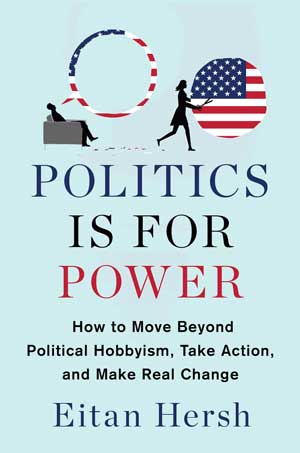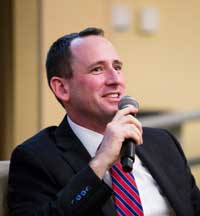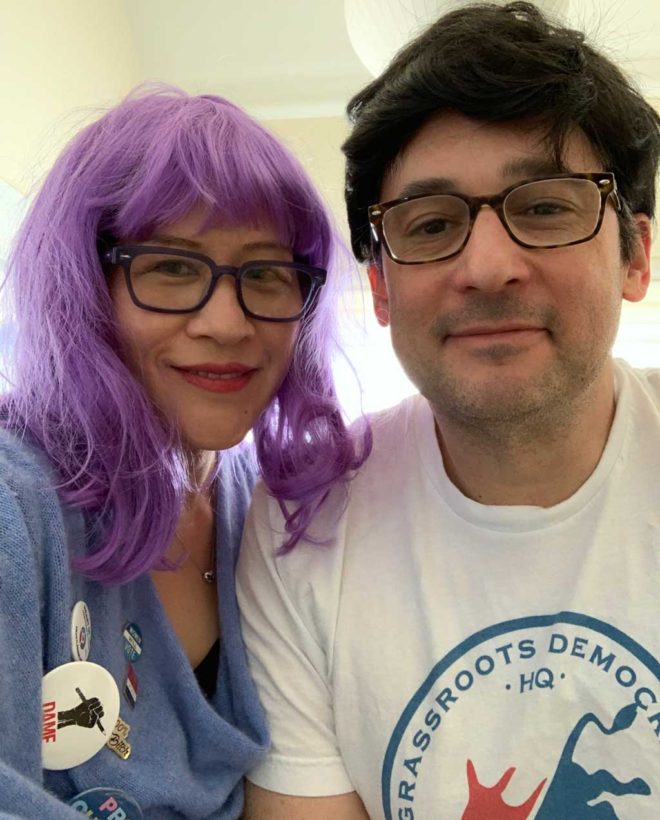POLITICS IS FOR POWER
by Eitan Hersh
Scribner, 288 pages
reviewed by Brian Colker
Buy the books in this article through Bookshop.org to support indie booksellers and Cleaver
 On a recent Sunday under quarantine, my spouse Susan Sheu and I donned costume wigs for our Zoom meeting. Twelve volunteers from the Los Angeles area sat at our respective kitchen tables, couches, and easy chairs and wrote postcards for California 38th District assembly member Christy Smith, who is running for Congress via a special election on May 12. Susan came up with the concept “wigging out for Democracy”; she thought that wearing wigs would be a festive and interesting way to make the Zoom meeting less tedious. It worked well: despite the quarantine and general malaise, wearing the wigs did add levity and made the afternoon go by faster.
On a recent Sunday under quarantine, my spouse Susan Sheu and I donned costume wigs for our Zoom meeting. Twelve volunteers from the Los Angeles area sat at our respective kitchen tables, couches, and easy chairs and wrote postcards for California 38th District assembly member Christy Smith, who is running for Congress via a special election on May 12. Susan came up with the concept “wigging out for Democracy”; she thought that wearing wigs would be a festive and interesting way to make the Zoom meeting less tedious. It worked well: despite the quarantine and general malaise, wearing the wigs did add levity and made the afternoon go by faster.
Eitan Hersh, a political science professor at Tufts University, believes that Zoom meetings like this are critical for progressives. In his new book, Politics is for Power, he contrasts volunteer activity with posting rants on Facebook or watching the news, which he brands “hobbyism”. For decades, organizers from Saul Alinsky, infamous ‘radical’ and author of the classic Rules for Radicals, and Harvard Professor Marshall Ganz, the intellectual godfather of Obama For America, have pondered how to get liberals off their couches (and off social media) to take meaningful action.
Hersh wants to know why so many educated white Americans consume a tremendous amount of news but rarely volunteer or perform any type of political activity. One-third of Americans spend two hours a day on politics, and 80% of this group are hobbyists. Most hobbyists are men, and they tend to be white. Hersh’s theory and worry is that hobbyism masquerades as activism, leaving a vacuum that bad actors or extremists are filling. He gives the ominous example of the North Carolina KKK helping get opioid addicts off the street and then recruiting them. The Klan is pursuing political power.

Prior to 2016, I was one of the hobbyists that irritate Hersh; after 2016, I became an activist (he uses the word ‘volunteer’). Hersh has had a similar journey: he and I both have the fanaticism of the newly converted. Hersh’s analysis veers off track in places, but I support his general thesis: partisan news consumption is rampant, and bad for democracy, and is hurting the volunteer actions that would strength the country. We need to rebuild the state parties from the ground up, and to do so means engaging face-to-face with neighbors in a way that delivers service to them.
Hersh traces hobbyism to the decline of party control over the nominating process (i.e., the popular primary model—which started in 1972) and the rise of cable news in the 1990s. Since the demise of the Fairness Doctrine in 1987, and the advent of cable, news has become written for outrage and to entertain partisans. This combination of populism and an unrestrained political media business model has created political news consumers.
This has caused partisanship to explode. As one would expect, the most partisan people tend to be the best informed. However, despite the popular cliché of uninformed rubes consuming Russian propaganda, the best informed are the biggest consumers of fake news:
The researchers found that participants who were most interested in and most knowledgeable about politics consumed fake news the most. Those people weren’t easily duped by the lies of fake news stories. They were sophisticated consumers who sought the fake stories because they are junkies.
Hersh’s conclusion is that hardcore partisans are literally addicted to the highly partisan rivalry, identical to a rabid sports fan. They are also less likely to interact with those on the other side (or, presumably, to volunteer).
The make-up of the most engaged donors and primary voters have become sharply ideological on both sides, so that moderate politicians are disincentivized from running for office, and those in office are punished for compromise and rewarded for starkly partisan positions. The media environment is amplifying this—conflict is more entertaining than long, technical debates that grind towards legislative compromise:
On cable and social media, ideologues call out politicians who veer toward compromise. They one-up each other in taking more extreme positions. A politician presents a proposal, and a news network can instantly find someone who is outraged that the proposal doesn’t go far enough to please her or her side. To an audience, the outraged hot takes are more interesting that the commentators praising compromise or deals that cede an inch to the opposition.
The fact that media broadcasts conflict, and partisans share these clips on social media, make politicians focus on their media presence and image, to the detriment of their relationships across the political spectrum.

Hobbyists are drawn to national politics almost exclusively—Hersh likens it to casual football fans watching the Super Bowl. They ignore statewide contests (other than voting down ticket) and have a dismal record voting in local political races, in which less than 1 in 5 voters participate. Local news is boring and for wealthier hobbyists, it doesn’t really matter much. Working class, immigrants, and other vulnerable groups have a much greater stake in local elections because those policies impact their daily lives. Hobbyists focus on emotional issues —think puppy mills—and on charismatic leaders and gossipy races. It’s the theater, not the power, that excites the hobbyist.
Hersh has a test for those who believe they are doing something more than news consumption: he asks if anyone would notice if you stopped your activity. For those volunteering, there tends to be a commitment and a network that expects the volunteer to show up for events and actions. Dropping out would lead to questions about what happened and why. Passive news consumers have no such expectations or relationships. Rachel Maddow doesn’t call viewers when they skip her news hour.
Hersh’s evidence of hobbyism is stark—less than 5% of the general population did any volunteering at all—a single action—for the 2016 elections:
Among daily news consumers in 2016, less than 4% reported doing any work whatsoever on behalf of a campaign or party that election year. Even among those who reported they were afraid of Donald Trump, only 5 percent reported that they did any work to support their side.
And even that number is largely exaggerated. It is not for lack of leisure time—Americans average 5 hours a day of it, which is largely spent watching something. African Americans and Latinos are three times likelier to volunteer than whites, due to a collective sense of threat and bound fate. More affluent whites lack this fear and can afford to treat politics like sports —something to be passionate about, but ultimately entertainment that has little bearing on their lives.
Hersh offers several explanations as to why this is: local party organizations are very weak (by design, as a reaction to the corruption and racism of local leaders in the 1940s-1960s) and the actions they ask volunteers to take don’t feel very meaningful—using a canned script to call, text, or door knock with—and they tend to be very top down.
Interestingly, sociologist Theda Skocpol notes that Tea Party Republicans are much more comfortable with this top-down model than liberals, which explains why the Tea Party was very effective during the Obama years. However, it is unclear why this is the case: other than resorting to gross generalizations, like Republicans are more authoritarian and follow orders unthinkingly, what would explain their willingness to volunteer more? I would want to know if they are more motivated to action by fear, for example.
Throughout the book, Hersh interviews people who have become political organizers and describes how they learned this activity and what they’ve done with their power. The thread through all the cases is that political organization is all about local, face-to-face networks and providing something the community needs—helping neighbors with their immigration issues, helping neighbors get someone onto a local school board, helping neighbors solve a problem. By providing basic services like babysitting, disaster relief, and elder services, Democrats can rebuild political power at the grassroots level. Providing services could be the secret sauce to building networks—especially across partisan divides.
Where I take issue with Hersh is his approach the book as both a neutral analyst and as a burgeoning democratic activist. His analysis of political partisanship and the media are framed as a ‘both sides’ argument. This ignores major differences in the two camps. The Democratic party, and progressives, have moved leftward since the 1990s, but the Republican party and Conservatism has become so ideologically extreme as to be unrecognizable as a mainstream political party. According to the Manifesto Project, which analyzes political platforms across the globe, the American Republican Party has grown more akin to a European far-right party. Per the New York Times’ analysis in June of 2019:
According to its 2016 manifesto, the Republican Party lies far from the Conservative Party in Britain and the Christian Democratic Union in Germany — mainstream right-leaning parties — and closer to far-right parties like Alternative for Germany, whose platform contains plainly xenophobic, anti-Muslim statements.
Tea party Republicans denying Obama was a US citizen, stoked by their version of ‘mainstream’ news, is hardly equivalent to liberals protesting a ban on Muslim immigrants, an outright xenophobic and illegal policy. Since Trump’s election, his party has embraced anti-democratic attacks on the rule of law, the separation of powers, the media, and on voting itself. Opposition to this administration is not just liberal partisanship equivalent to the Tea Party movement. Resistance groups like Indivisible rose in 2016 as a desperate attempt to rescue American government itself, in addition to advancing a liberal policy agenda.
The book would have been stronger had Hersh not attempted to generalize his argument across the political spectrum. He is clearly not a Republican of the Trump era, nor does his analysis touch on why they have embraced radical anti-democratic values which would have been unthinkable as recently as the early 2000s.
Hersh describes on a key element of volunteerism that is highly problematic—the boring and robotic nature of volunteer engagement. Scripted calls, texts, hand-writing writing postcards and door knocks are not exciting ways to pass the time. This may explain a fundamental reason why people choose passive consumption over volunteerism—the former is effortless. Saul Alinsky, in Rules for Radicals, discusses a principle of organizing—it must be creative and have an element of fun. Hersh misses an opportunity to go deeper on this subject, because it is crucial for understanding the disconnect between the hobbyist and the volunteer. The local leader who rules the small organization recruit for foot soldiers to do the tedious work. For many affluent whites, this work is uninspiring and beneath their perceived skill level. Mid-career professionals do not relish tedious work, but more to the point—they don’t like following directions.
Volunteers need to feel better after an event. It is not JUST about servicing their needs—their emotional need for connection and efficacy must be harnessed. The same rules for talking to voters apply to volunteers—they need to be offered a genuine ability to contribute in a way THEY find meaningful. If a hobbyist is induced to make phone calls for a campaign, she or he will need to be recruited and managed with care to ensure it is a positive experience and it will be repeated.
One reason the Obama campaign was so successful in recruiting huge numbers of volunteers is that it encouraged small local groups (five to ten people) to work together. People were able to work with their friends and feel like they had a lot of autonomy. It also allowed the groups to be nimble and change strategy as the campaign went on.
Hersh’s book is an important one for Democrats and those who oppose Trump and Trumpism in 2020—we will need an army of volunteers to take back power at the local, state, and federal level, and hopefully the book will motivate some hobbyists to turn off the news and get off twitter.
 Brian Colker is a management consultant for benefit organizations and a grassroots organizer in Los Angeles. He is CFO of the Grassroots Democrats HQ.
Brian Colker is a management consultant for benefit organizations and a grassroots organizer in Los Angeles. He is CFO of the Grassroots Democrats HQ.
Read more from Cleaver Magazine’s Book Reviews.



